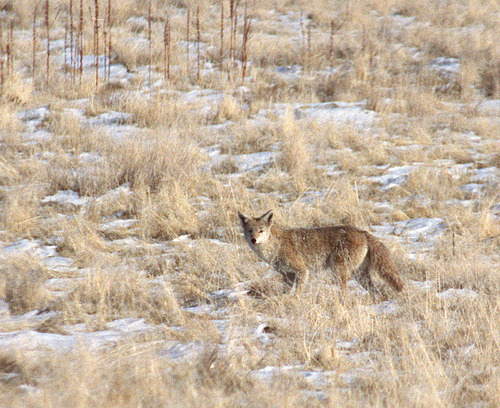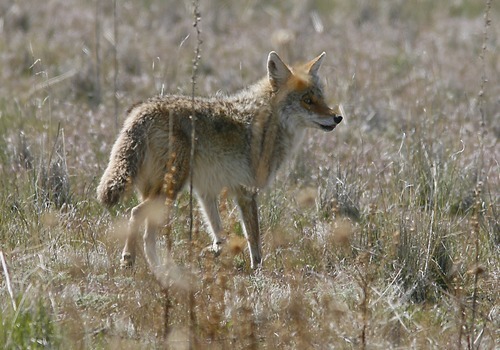This is an archived article that was published on sltrib.com in 2012, and information in the article may be outdated. It is provided only for personal research purposes and may not be reprinted.
It might become the closest thing to a feral cat bill in the 2012 Legislature.
Coyotes could wind up with a price on their head, with one lawmaker looking to pay $50 for each pair of ears from animals that have been shot or trapped, a plan that could encourage hunters to kill more than 20,000 of the animals.
Sen. Ralph Okerlund says coyotes are jeopardizing Utah deer herds and doing extensive damage to sheep and cattle herds and is proposing raising the bounty.
"We've got a lot more coyotes than we've got livestock and wildlife now and we need to do something about that," the Monroe Republican said. "What we're hoping is this will encourage a lot more people to go out and hunt these animals."
There already is a smaller bounty program in place. Currently, hunters or trappers in certain counties that turn in a pair of coyote ears can be paid $20: $10 from the county, matched by $10 from the state.
But Okerlund said when gas and supplies are taken into account $20 isn't enough incentive to exterminate this member of the dog family. His SB245 seeks to raise the bounty, using the revenue from a $5 increase in fees for hunting licenses and additional funds from the state.
Last year, the House considered a bill that would allow feral cats and birds to be shot to try to control the nuisances. It created a stir among animal rights groups and a sideshow before it was abandoned.
Don Peay, president of the group Sportsmen for Fish and Wildlife, said the goal of the coyote control is to infuse $1 million into the program, which could remove 20,000 of the predators. Peay said sporting groups could give additional funds to control coyote populations.
"That's going to be local economic development, because it will send a lot of people out into remote parts of Utah, buying gas and hotels and lodging," Peay said. "Plus it will increase the deer herd and if the deer herd continues to decline, people aren't going to come here and buy hunting licenses."
But Gene Baierschmidt of the Humane Society of Utah said the bill could encourage indiscriminate killing, "annihilating all the coyotes" in one area that does nothing to help the deer populations. The group also opposes the use of traps and poison as inhumane.
"We think the whole idea of a bounty system is kind of abhorrent to us," Baierschmidt said. "It is very controversial and the question has to be asked is: Is it based on science or is it just based on guesswork?"
Peay said the Division of Wildlife Resources has spent $75 million restoring deer habitat, but studies have shown deer populations are stagnant or declining.
The Utah Division of Wildlife Resources also does coyote control and has spent $3.4 million over the past six years hiring trappers and aerial hunters to kill the predators, focusing efforts during the breeding season.
Okerlund said he decided to sponsor the bill after a constituent reported losing $30,000 worth of lambs to coyotes after he moved to a new lambing range.
"This program is really targeted more toward the livestock-men than the sportsmen," he said.
Sterling Brown of the Utah Farm Bureau Federation said the group supports the bill because coyote populations have increased and are claiming up to 15 percent of newborn lambs.
"Predators in general, coyotes being one of them, have taken a huge toll on the livestock community and wildlife community," he said. "Our wildlife services management says there are more coyotes out on the ranges over the years and there's been increased regulation from the federal government that restrict what ranchers can do to restrict or control them."
He said the government has restricted how ranchers can trap coyotes. Okerlund's bill would get more predator control resources on the ground. —
Wolves as targets
Wolves, once listed as an endangered species, could be a target for hunters under a bill pending in the Utah Senate.
SB22, sponsored by Sen. Allen Christensen, R-Ogden, would allow the Division of Wildlife Resources to sell hunting licenses for wolves in the state, similar to the hunt for bears and cougars.
It is unclear whether there are any wolves in Utah and, if there are wolves, how many there are. There have been various sightings reported around the state.
"Technically, there are none," Christensen said. "But I've heard so many reports [that] there's a pack down here and there's a pack there and they're ripping things up."
But Christensen said he is getting pressure from sportsmen to go further
"A lot of people want to put it in the classification of coyotes so you can shoot it on sight, anytime, anywhere," Christensen said.
Don Peay, president of the Sportsmen for Fish and Wildlife, said Utah is trying to get "ahead of the curve" when it comes to controlling wolf populations.
"The federal government has failed to keep its word on anything in the last 20 years on the wolf issue and the wolf advocates more importantly violated their agreements to keep it to 150 animals in each state," Peay said. "Until there's some honesty and integrity, we don't want any wolves."









